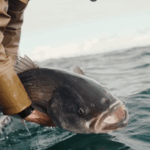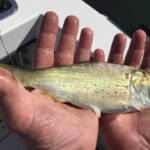
Release Mortality Revisited: New Research from Massachusetts DMF
Feature Photo Credit: Robbie Tartaglia What’s going on? For decades, striped bass management relied on a
By Will Poston, Policy Associate
For months, we’ve been eagerly awaiting the first bits of information coming out of the 2022 Striped Bass Stock Assessment Update and, in turn, what that will mean for rebuilding the stock by 2029. Well, last week, on August 10, we got our first look at some initial outcomes from the stock assessment at a Atlantic States Marine Fisheries Commission’s (ASMFC) Striped Bass Technical Committee (TC) and Stock Assessment Subcommittee meeting. Before we get into what was discussed at the meeting and what that means for the stock and management, please understand two things: 1) We are not stock assessment scientists and are simply reporting on what was discussed at the meeting; and 2) the TC discussions were based on the initial stock assessment model runs and are not final. We’re sharing the information that we heard and will try to stay in that lane. As things stand now, the striped bass stock is no longer experiencing overfishing, but it remains overfished (though spawning stock biomass is showing a slight uptick), and additional reductions—though not as severe as we initially feared—will likely be needed for 2023 in order to rebuild the stock by 2029.
Some of you may ask, “why are you guys tracking the first discussions on preliminary stock assessment information so closely?” Well, it’s no secret that the implications of this assessment update are huge for the ASMFC’s rebuilding of the striped bass stock. The ASMFC is required to rebuild striped bass by 2029, because they were declared overfished in 2019 based on a stock assessment that included data through 2017. However, as many of you probably recall, no rebuilding plan was adopted back then; instead, the Striped Bass Board approved Addendum VI in October 2019 to address the overfishing and mortality issue, but explicitly aiming to rebuild by 2029 was not an inherent part of that action.
Fast-forward to May 2022, when the Board approved Amendment 7. Amendment 7 authorized the Board to approve new 2023 management measures by a majority vote if the stock is not projected to rebuild under the current management by 2029 according to this upcoming stock assessment. So, this assessment, once finalized, will show us whether the ocean’s slot limit and other measures are proving effective, where SSB (biomass) estimates are, and if the current management regime will rebuild the stock by 2029.
As a quick aside, many people that follow striped bass management and have a good grasp of the coastwide fishery have been pretty worried about what this assessment might say. To a degree, we saw some of that at the Summer ASMFC meeting, where most Board members seemed ready to act quickly to rebuild this iconic species. So, the Board does seem intent and prepared to do what the stock assessment dictates, which we are encouraged by and attribute that in part to the public pressure they felt from you all over the past two years.
Now, let’s dive into what we heard at last week’s TC meeting. The 2022 Striped Bass Stock Assessment will be an assessment update that includes new data from the 2018 through 2021 fishing years—thus updating the previous 2018 Benchmark Stock Assessment (which used data through 2017). The TC spent much of the morning discussing the merits of two potential selectivity options—that is, considering a change in size-at-harvest for 2020-2021 compared to previous years given the new slot limit. They also considered whether to account for a newfound and concerning bias in the stock assessment model that leads to past overestimates biomass and underestimates of fishing mortality. We know this is all painfully technical, so will leave it at that for now, but suffice it to say that the TC still has some issues to work through in the next few months before the assessment is finalized.
These two issues have bigtime implications on the stock assessment and rebuilding, which is why the TC and stock assessment folks spent so much time discussing them. Ultimately, the group chose to do another model run and make final decisions on whether to use the new selectivity block and whether to correct for bias at subsequent meetings.
However, we did see where/what condition the initial stock assessment run puts the stock at and its projections on rebuilding (apologies for the slightly-blurry screenshot):

According to the initial stock assessment run, the striped bass stock is no longer subject to overfishing, as you can see in the top plot (orange line below the dashed horizontal line; fishing mortality below threshold). The stock is still overfished, as you can see in the bottom plot (orange line below dashed horizontal line; female spawning stock biomass below threshold), but there appears to have been a slow uptick in biomass in recent years. So, at this initial stage, it looks like the slot limit and other measures under Addendum VI are working, which we are thrilled about.
That being said, under most of the projection scenarios, we will need to take additional reductions and develop new measures in 2023 to rebuild the stock’s biomass to the target by 2029. According to the various projection scenarios those fishing mortality reductions could be: 27.1%, 24.1%, or 9.1%. Alternatively, one projection produced a scenario where we could liberalize by 17%. For reference, Addendum VI was intended to achieve a 18% reduction to end overfishing. These projections vary based on the decisions the group still needs to make regarding whether to include the new selectivity blocks and whether to correct for bias.
While there was no final decision on those questions, there seemed to be more support for correcting for bias and a hybrid selectivity approach (new selectivity block for the ocean and old block for the Chesapeake Bay because the Bay’s regulations did not change as much as they did for the ocean). Projections were not calculated for that decision matrix. However, the projections under the “correct for bias scenarios” result in 24.7% and 27.1% reductions, which are likely manageable given the management tools at our disposal—and not the worst-case condition some were anticipating.
Here at ASGA, we trust science. Heck, we rely on it and believe in its utility for sustainably managing our fisheries. We support and commend the hard work of the Striped Bass TC and ASMFC staff. We look forward to future discussions and gaining a fuller picture about what rebuilding may entail. But in the meantime, based on the info we have to do, it looks like we are doing a decent job at controlling fishing mortality, and biomass is starting to increase—just not fast enough to rebuild by 2029. Stay tuned for future updates as the stock assessment scientists get closer to a final product.

Feature Photo Credit: Robbie Tartaglia What’s going on? For decades, striped bass management relied on a

Recent developments in the 2025 Atlantic Menhaden Stock Assessment Update, released by the Atlantic States

What’s going on? The “most important fish in the sea” just exposed one of the

Mario CampoFisheries Ecologist, Southeastern Louisiana UniversityScience and Policy Associate, American Saltwater Guides Association This discussion
We rely on our members and donations to keep fighting for a sustainable tomorrow in marine conservation.
GIVE THE GIFT OF FISHERIES CONSERVATION THIS HOLIDAY SEASON. SHOP ASGA GOODS THAT FUND FISHERIES RESEARCH & ADVOCACY CAMPAIGNS
JOIN ASGA IN CALLING FOR CRITICAL MANAGEMENT ACTION AFTER YEARS OF SPAWN FAILURES & POOR MANAGEMENT.
By using this website, you agree to our use of cookies. We use cookies to provide you with a great experience and to help our website run effectively. To learn more, please review our privacy policy.
One Response
“Alternatively, one projection produced a scenario where we could liberalize by 17%.” Congratulations to the ASGA for providing information to the angling public and for their trust in science, but the fact remains that the managers can do with the science what they want; they have proven that in the past. It really is mind boggling that given what has happened over the past decide that any data or model could produce a scenario where more fish could be killed.
I still believe they blew it when they kept the slot limit in place; from what I have seen up here on the Cape and in photos posted by the charter fleet, the 2015 year class in under assault and will continue to be overfished as long as the slot remains in place for the next, say, four or five years and whatever remains of that class are still available for “keeping.” States like Florida have the flexibility to make changes in the slot for species like snook from year-to-year based on spawning success and other data. I guess changes in bass management are wrapped up in the rigamarole of a multi-state management plan, which is too bad.